Last Friday I showed off Boeing’s 360 view of a Boeing 737 (nicknamed the “gigaplane”) and asked how many photos it took to make this one of a kind view. When the first few “around 20,000” answers started rolling in, I thought people were pretty good. Then I realized that other sites and even Boeing had covered the 360 view and stated it was “around 20,000.” I guess I cannot blame people for doing research, but luckily the “real” answer is not an even 20k — I do not have that many prizes.
So what is the exact answer? According to Boeing it is 22,240.
There were a lot of guesses and I appreciate the involvement, but who got closest? Well, I am giving props to the two who were the closest: Ariff Shah from Moscow who was only off by 240 and Allen Cheng from Langley, BC who was off by 260. So what do they win besides uber props on the blog?
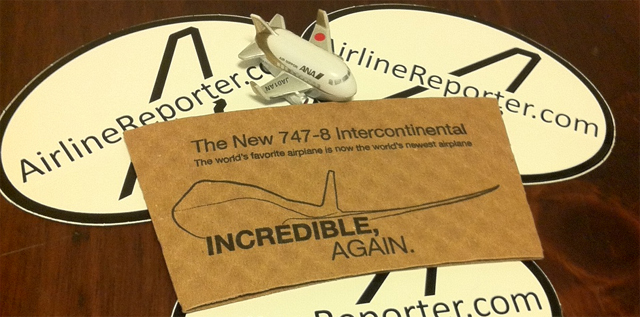
These are the fabulous prizes for the Boeing 737 360 giga-plane contest. Good stuff.
They will both be mailed the prizes above: three AirlineReporter.com stickers, one magnet of an ANA Boeing 737 and last, but surely not least a coffee cup holder I got during the first flight of the Boeing 747-8 Intercontinental. For the average person, the paper coffee holder means nothing, but for the true aviation geek, this is gold.
The video above shows behind-the-scenes on the making of the gigaplane image created by Boeing. It seems that fans are not the only ones excited about the giga-image. Rahsaan Johnson, the Director of United’s Communications told AirlineReporter.com, “Boeing is a great partner and the 737 is a great airplane, so we’re happy to join them in showing it off.”
A huge thanks to Boeing for creating and sharing this image with the general public — I hope we see more like it in the future.
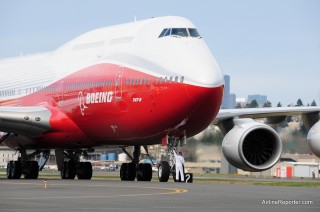
The first Boeing 747-8 Intercontinental after landing at Boeing Field after her first flight.
Some media outlets are reporting that the FAA partial shutdown could affect the certification of the Boeing 787 Dreamliner, the 747-8 Freighter and 747-8 Intercontinental. According to Boeing, as of now, the partial shut down will not affect the certification of the aircraft, but could affect airports looking to be certified to operate the new 747-8.
“The FAA says airplane certification activities will continue– so we don’t expect any impact there,” Boeing spokesperson Doug Alder Jr explained to AirlineReporter.com. “As for airport certification, if furloughed FAA personnel don’t return to work in time to finish the remaining airport approvals for the 747-8, customers wouldn’t be able to fly the airplane into certain airports until that work is complete (SFO, Newark, O’Hare and Houston are the major ones).”
This is just another reason to be angry at the partial FAA shutdown.
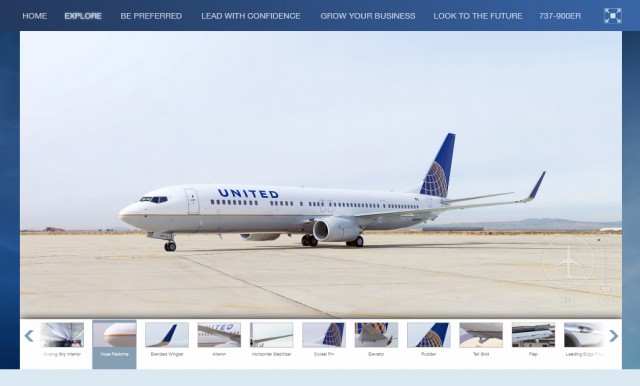
Screen shot of Boeing's Explore 737 page highlighting the 360 view of a United Boeing 737-900ER (N36444). Click the image to be taken to the interactive view.
The Boeing 737 is the bestselling airliner in the world and for good reason. The first flew on April 9, 1967 and even though the aircraft has changed quite a bit over its 42 year history, it is still easily recognizable. Recently, a brand spanking new United 737-900ER had one heck of a 360 view created in its honor. I had the opportunity to speak with Anthony Ponton, 737 Brand Manager, via the phone to learn a bit more about the process it took to create such a unique image.
Ponton explained how it was actually quite difficult for Boeing to get their hands on a completed aircraft. Normally they are built and handed over to the airline quickly. If the plane is sitting on the ground, it isn’t making any money — for anyone. This 737 (N36444) ended up having a week free, so United allowed Boeing to take it down to Victorville, CA (KVCV) to do the photo-shoot. Well, the word “photo-shoot” really does not give this project justice. The crew spent almost an entire day (8:30am-3:30pm) taking photos (guessing the number of photos taken is the contest — see below) from about 150′ away to create the 360 view.
This is truly a one of a kind project that uses Microsoft’s Silverlight technology. The Boeing 737 360 view has even been submitted to the Guinness Book of World Records for being the largest giga-pixel image of a single object — impressive. Boeing created this not only for their airline customers, but also to share with airline fans. They wanted to use a high-technology method to highlight the technology used on the current 737 family.
The view really let’s you explore the 737 in great detail. You can zoom all the way in to see rivets or read the safety messages on the aircraft’s doors. When asked if Boeing might do this with other aircraft types, Ponton was not so sure. He explained how completing this 360 on Boeing’s smallest aircraft was already a challenge and a larger aircraft would only be more difficult. Of course, that is not to say that Boeing might not be up to the challenge.
CONTEST: How many photos did Boeing use to make this 360 view possible?
Boeing spent a long time taking all the photos needed to make this impressive view and I am holding a contest to see who can come closest to how many it took. I have been told the official number by Mr. Ponton and whomever gets closest will get a fun prize. I am not sure exactly what the prize will be, but if you keep your expectations low, you won’t be disappointed. You will have until 5pm PT on Tuesday August 2nd, 2011. You can either leave a comment or send an email to da***@*************er.com with your answer. Good luck!
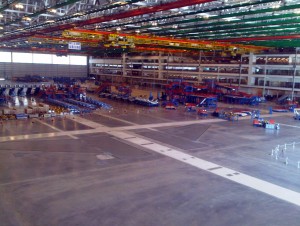
The new Final Assembly Building in South Carolina
Boeing has been busy this week releasing one important press release after another. I am a little behind still, so I decided to put them all in one easy to follow blog to keep everyone updated:
BOEING OPENS NEW SOUTH CAROLINA 787 FINAL ASSEMBLY BUILDING
Boeing has officially opened the second location where the Boeing 787 Dreamliner will be built – North Charleston South Carolina. Although the 787 is a bit behind schedule, the new facility was completed six months ahead of its origional schedule. The final assembly of the first South Carolina-built 787 Dreamliner will begin later this summer. Once up and running, the facility is expected to produce three 787 Dreamliners per month.
The new Final Assembly building encompasses 642,720 square feet and used one million cubic feet of concrete. Compare that to the Boeing Factory in Everett, WA being 4,299,967 square feet.
BOEING STARTS SHARING ON FLICKR
If you read the blog, you know I have loved following Boeing through their social media exploration. Not too long ago, they started a YouTube account adn now they have started Flickr — be sure to follow.
AIRCRAFT DELIVERY MILESTONES
This week Boeing delivered their 50th aircraft to Egyptair and their 275th Boeing 737 Next Generation to GE Capital Aviation Services (GECAS). Boeing also delivered Angola Airline’s first 777-300ER.
BOEING 747-8F FLYING TO PARIS ON BIOFUEL
This will be the first time that an airliner has flown across the Atlantic Ocean using BioFuel. Boeing pilots Capt. Keith Otsuka and Capt. Rick Braun and Cargolux Capt. Sten Rossby will fly the airplane with each of the 747-8 Freighter’s four GE GEnx-2B engines powered by a blend of 15 percent camelina-based biofuel mixed with 85 percent traditional kerosene fuel (Jet-A).
BOEING EXPECTS DEMAND FOR 33,500 NEW PLANES OVER NEXT 20 YEARS
That is a lot of moola — about $4trillion to be exact. Boeing forcasts that the world fleet will double by 2030 and obviously want to get in on the action. Boeing is concentrating on growth in China and India with most new aircraft deliveries taking place in Asian Pacific countries.
Image: Boeing
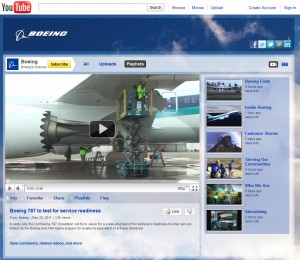
Screen shot of Boeing's new YouTube channel
Social media has become a must-have for most large companies today. Some will approach it with a thought out approach and others do not really know why they are on social media, but just feel they are supposed to be on it. I have enjoyed following Boeing’s slow approach to social media and applaud them for recently adding a YouTube channel.
When I first started this blog about three years ago, the idea of Boeing being on social media was a very foreign concept. Slowly, but surely they have moved from being a company with a closed-door culture to being one that is much more open and shares what is going on with customers and fans of their product.
Boeing first started with operating three Twitter (what is Twitter?) accounts: @Boeing, @BoeingAirplanes and @BoeingDefense. The Twitter accounts cover much more than just repeating news that is already out in the public domain. They have had contests, shared unique photos and personally connected with some of Boeing’s biggest fans.
So why is Boeing on Twitter and YouTube, but not Facebook? Well, the Boeing Store has a Facebook account, but to date Boeing proper still does not. Is this a bad move? Possibly not. Boeing has been taking the “easy-does-it” approach to social media, making sure they master each one before moving onto the next.
When talking to Boeing, it is clear they are looking at how to expand their presence on social media globally, versus just American-based platforms. “We are a global company, ” Todd Blecher, Director of Boeing Communications explained to Airline Reporter. “We need to find ways of becoming a global social media participant.” For example Twitter is not all that popular in China, so Boeing has decided to create a Weibo account to connect with local people and companies.
Adding a YouTube channel is smart, since Boeing is already producing the content. For a long time, Boeing has produced videos to share with employees and it has only been more recently that they have shared these videos via their website. Posting them on YouTube allows more people to view the videos and more importantly, it allows people to comment and interact with Boeing.
YouTube is not the only new thing for Boeing’s videos. On the recent American Airline’s Sky Interior delivery flight, there were only about 20 people on board and Boeing asked a few of the customer-fans who were invited by American Airlines to walk up and down the aircraft at 30,000 feet and give their impression of what they think. No script, no direction, just take a look at the aircraft and give your raw opinion (note: the video has not yet been posted). This is the first time that I have seen Boeing do something like this and it really is a new level of connecting with fans.
Will Boeing continue to grow in other social media formats? I would assume so, but I have been impressed how they continue to better the social media channels they have now to best interact with people outside their company and I look forward to watch them grow.




